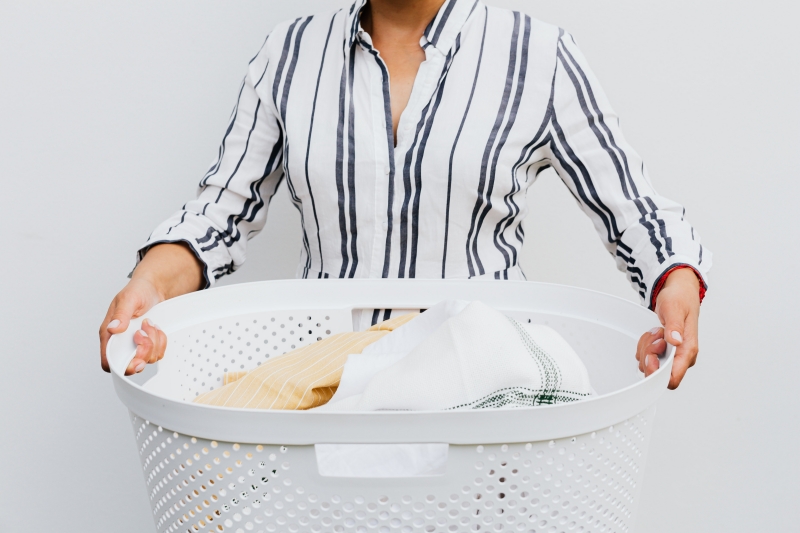One of the most frustrating things about doing your laundry is finding your clothes covered in lint.
After letting your garments run a cycle in your washing machine with dryer, you expect them to come out spotless, ready for another #OOTD. Unfortunately, unlike ordinary stains that can be dealt with hydrogen peroxide, bleach, or even just a few more minutes of soaking in detergent, lint isn’t as simple to handle.
Lint is produced from fabric fibers that are broken apart from your clothing. This occurs due to friction and heat from the washing and drying cycles of your washing machine, as well as everyday wear and tear. If lint isn’t dealt with properly, it could ruin the appearance of your clothes, as well as weaken their fabric. Lint can also accumulate in your washing machine, which can affect its performance. Worse, lint can even pose a fire hazard in extreme cases because the excess fluff in the washing machine can catch fire in case of overheating.
Fortunately, there are several solutions you can apply to ensure that your clothes stay lint-free. Here’s a list of things you can do to reduce and eliminate lint from your clothes to keep them stylish and make them last longer:
Clean Your Washing Machine
Lint can build up inside your washing machine and can transfer to your clothes during the wash cycle. As such, regularly cleaning the drum and lint filter can make a significant difference. Use a damp cloth to wipe down the drum after every wash to remove lint and other residues. You should also ensure that the lint filter is clean before each wash. With this simple maintenance routine, you’ll prevent lint from accumulating on your clothes and maintain your appliance’s performance.
Keep Your Laundry Sorted
Before starting the laundry process, take a moment to sort your clothes. Separate your dark-colored garments from the light-colored and white ones to prevent lint transfer. Delicate fabrics like silk or chiffon should also be washed separately from rougher materials like denim. This practice reduces friction and minimizes lint production during washing and drying.
Prep Your Clothes Before Putting Them in the Wash
Properly preparing your clothes before washing them can go a long way in keeping them lint-free. First, turn your clothes inside out. This minimizes the fabric’s exposure to other garments and reduces lint production. Next, fasten zippers and buttons on clothing items. Loose fasteners can rub against other fabrics, causing friction and generating lint. These simple steps can make a noticeable difference in the amount of lint on your clothes after washing.
Use Gentle Washing Cycles and Low-Heat Drying
The settings you choose on your washing machine and dryer can impact lint production—the harsher the wash and dry cycles, the more lint will be produced. Thus, it’s better to use gentle washing cycles whenever possible, especially for delicate fabrics. Aggressive cycles can cause fabrics to “shed” more. Similarly, use low-heat settings on your dryer. High heat can damage fabrics and result in more lint production.
Reduce Static from Your Clothes
Static electricity is a common culprit for lint sticking to clothes. To combat this, consider using fabric softener during your laundry routine. Fabric softeners reduce static cling, making it less likely for lint to attach to your garments. However, make sure to use fabric softener sparingly; too much of the product may leave a filmy residue on your clothes.
If you don’t want to use fabric softener, you can use distilled white vinegar instead to both soften your clothes and reduce static. When using distilled white vinegar, pour about 1/4 or 1/2 cup of it into your washing machine during the final rinse, depending on the wash load.
Another option is to make your own fabric softener using hair conditioner and distilled water. Simply mix one cup of conditioner with three cups of distilled water into a bottle. To use this mixture, pour about 1/2 to 1 cup of the homemade fabric softener into the machine during the rinse cycle.
Use a Lint Roller
A lint roller is a handy tool that offers a quick and effective way to remove lint from your clothes to keep them looking fresh. Just roll the sticky surface of the lint roller over your clothing and watch as it picks up lint and other particles.
Use Masking Tape
If you don’t have a lint roller available, masking tape can also remove lint. Wrap a piece of masking tape around your hand with the sticky side facing out before lightly pressing it onto the lint-covered area. Peel the tape away and the lint should stick to it. Repeat as needed until your clothes are lint-free.
Use an Old, Clean Toothbrush
For more stubborn lint or lint that has become embedded in the fabric, an old, clean, soft-bristled toothbrush can be surprisingly effective. Gently rub the head of the toothbrush on the lint-covered area, following the direction of the weave of the fibers. This will help loosen and lift the lint from the fabric.
Consider Getting Dryer Sheets
Dryer sheets add a pleasant fragrance to your laundry and help reduce static and lint buildup. Toss a dryer sheet into your dryer with your clothes and it will work to minimize lint transfer between garments.
Removing lint from your clothes can be challenging, especially since it can stubbornly come back due to your washing habits. At times, dealing with lint may seem like an impossible task. However, with the lint removal strategies in this list, you’ll have an easier time keeping your clothes looking neat and in good condition longer.




















